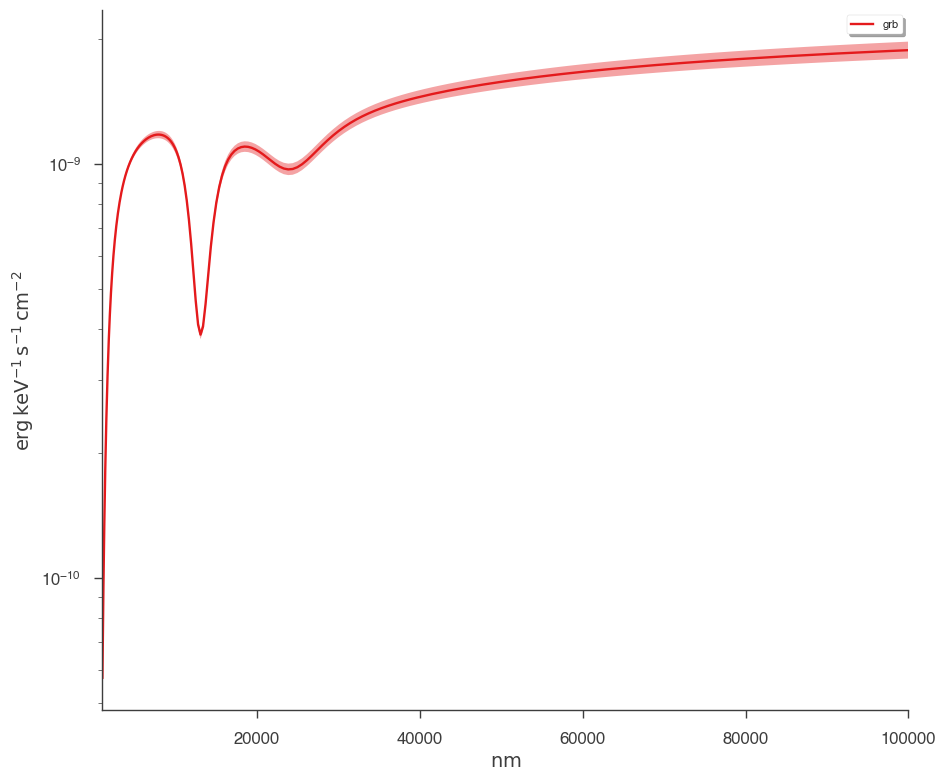Photometric Plugin
For optical photometry, we provide the PhotometryLike plugin that handles forward folding of a spectral model through filter curves. Let’s have a look at the avaiable procedures.
[1]:
import warnings
warnings.simplefilter("ignore")
import numpy as np
np.seterr(all="ignore")
[1]:
{'divide': 'warn', 'over': 'warn', 'under': 'ignore', 'invalid': 'warn'}
[2]:
%%capture
import matplotlib.pyplot as plt
from threeML import *
# we will need XPSEC models for extinction
from astromodels.xspec import *
# The filter library takes a while to load so you must import it explicitly.
from threeML.utils.photometry import get_photometric_filter_library
threeML_filter_library = get_photometric_filter_library()
[3]:
from jupyterthemes import jtplot
%matplotlib inline
jtplot.style(context="talk", fscale=1, ticks=True, grid=False)
silence_warnings()
set_threeML_style()
Setup
We use speclite to handle optical filters. Therefore, you can easily build your own custom filters, use the built in speclite filters, or use the 3ML filter library that we have built thanks to Spanish Virtual Observatory.
If you use these filters, please be sure to cite the proper sources!
Simple example of building a filter
Let’s say we have our own 1-m telescope with a Johnson filter and we happen to record the data. We also have simultaneous data at other wavelengths and we want to compare. Let’s setup the optical plugin (we’ll ignore the other data for now).
[4]:
import speclite.filters as spec_filters
my_backyard_telescope_filter = spec_filters.load_filter("bessell-R")
# NOTE:
my_backyard_telescope_filter.name
[4]:
'bessell-R'
NOTE: the filter name is ‘bessell-R’. The plugin will look for the name after the ‘-’ i.e ‘R’
Now let’s build a 3ML plugin via PhotometryLike.
Our data are entered as keywords with the name of the filter as the keyword and the data in an magnitude,error tuple, i.e. R=(mag,mag_err):
[5]:
my_backyard_telescope = PhotometryLike.from_kwargs(
"backyard_astronomy",
filters=my_backyard_telescope_filter, # the filter
R=(20, 0.1),
) # the magnitude and error
_ = my_backyard_telescope.display_filters()
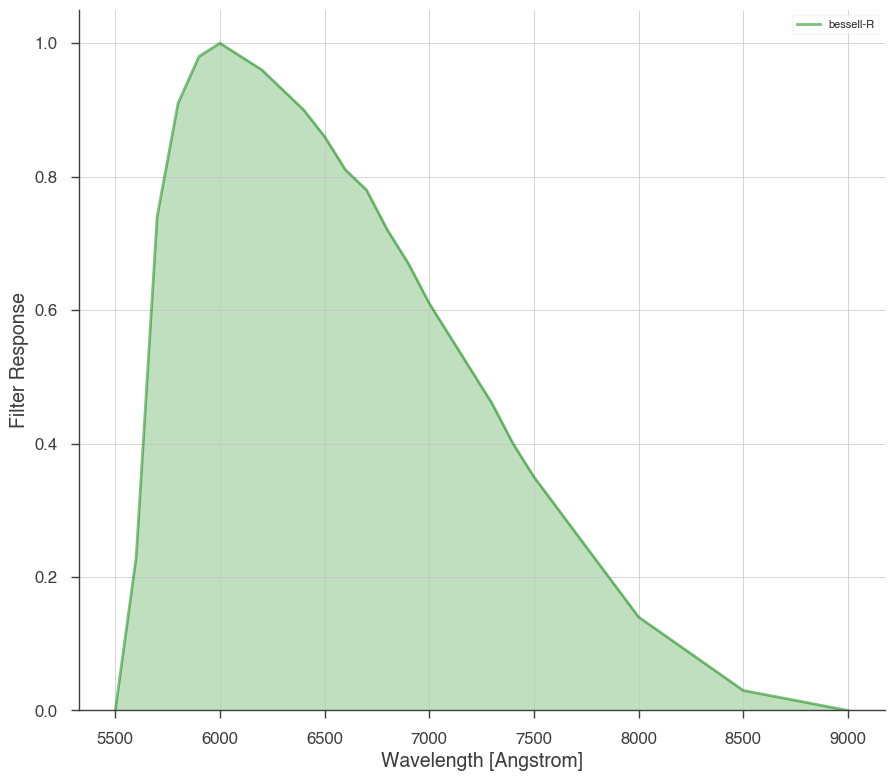
3ML filter library
Explore the filter library. If you cannot find what you need, it is simple to add your own
[6]:
threeML_filter_library.SLOAN
[6]:
SDSS: SDSS
[7]:
spec_filters.plot_filters(threeML_filter_library.SLOAN.SDSS)
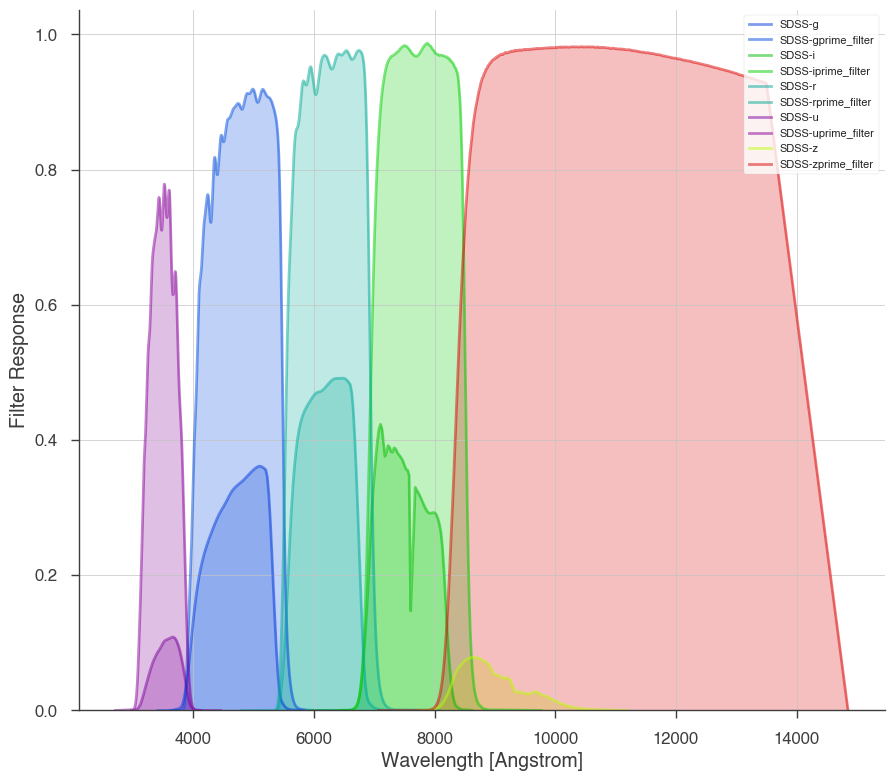
[8]:
spec_filters.plot_filters(threeML_filter_library.Herschel.SPIRE)
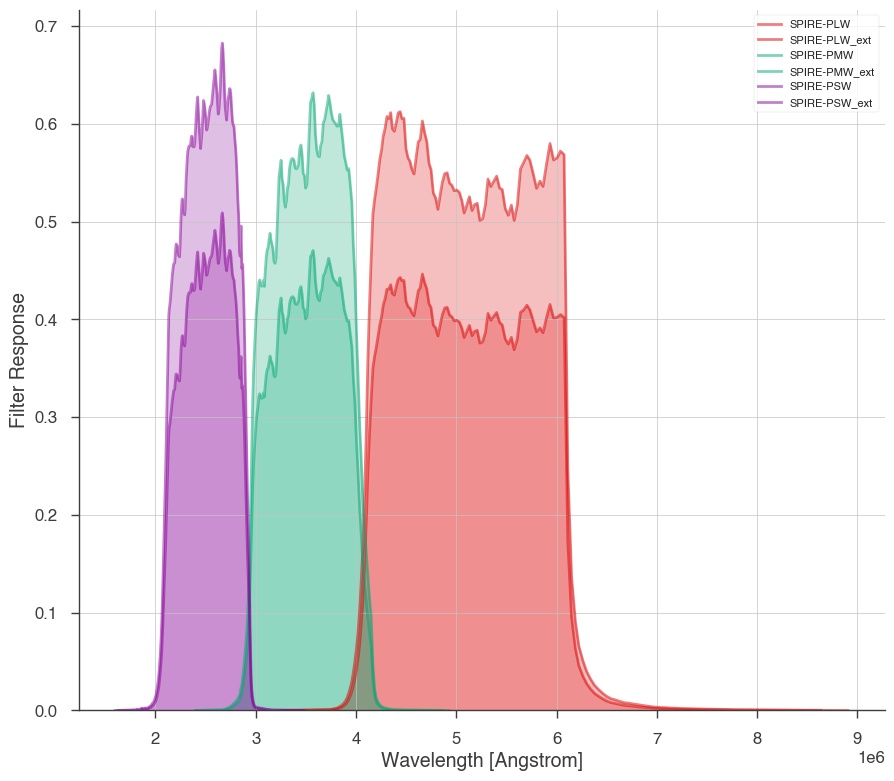
[9]:
spec_filters.plot_filters(threeML_filter_library.Keck.NIRC2)
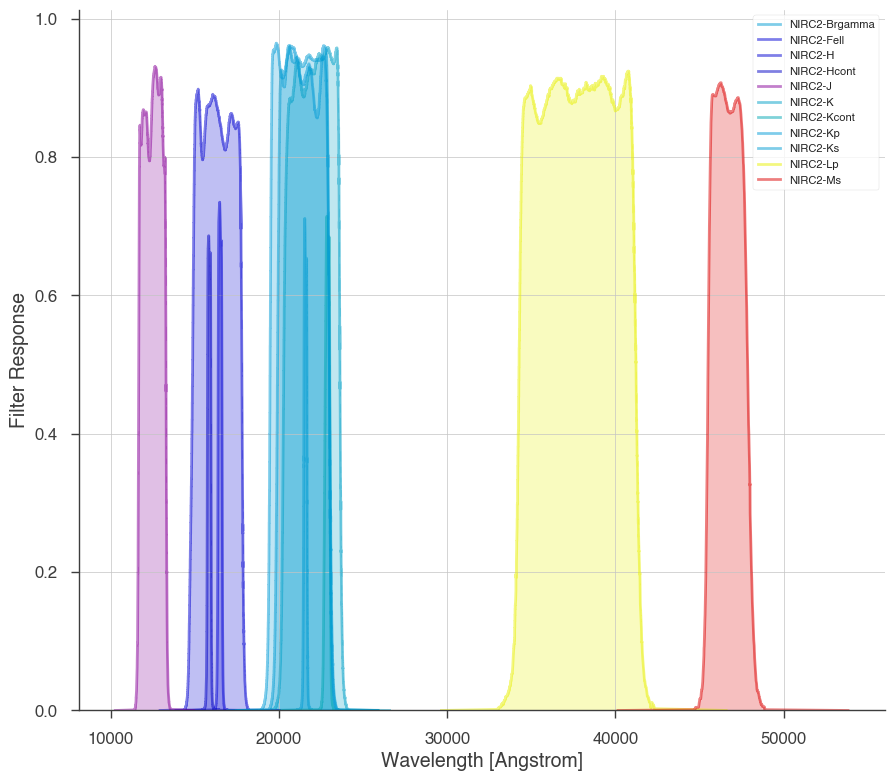
Build your own filters
Following the example from speclite, we can build our own filters and add them:
[10]:
fangs_g = spec_filters.FilterResponse(
wavelength=[3800, 4500, 5200] * u.Angstrom,
response=[0, 0.5, 0],
meta=dict(group_name="fangs", band_name="g"),
)
fangs_r = spec_filters.FilterResponse(
wavelength=[4800, 5500, 6200] * u.Angstrom,
response=[0, 0.5, 0],
meta=dict(group_name="fangs", band_name="r"),
)
fangs = spec_filters.load_filters("fangs-g", "fangs-r")
fangslike = PhotometryLike.from_kwargs("fangs", filters=fangs, g=(20, 0.1), r=(18, 0.1))
_ = fangslike.display_filters()
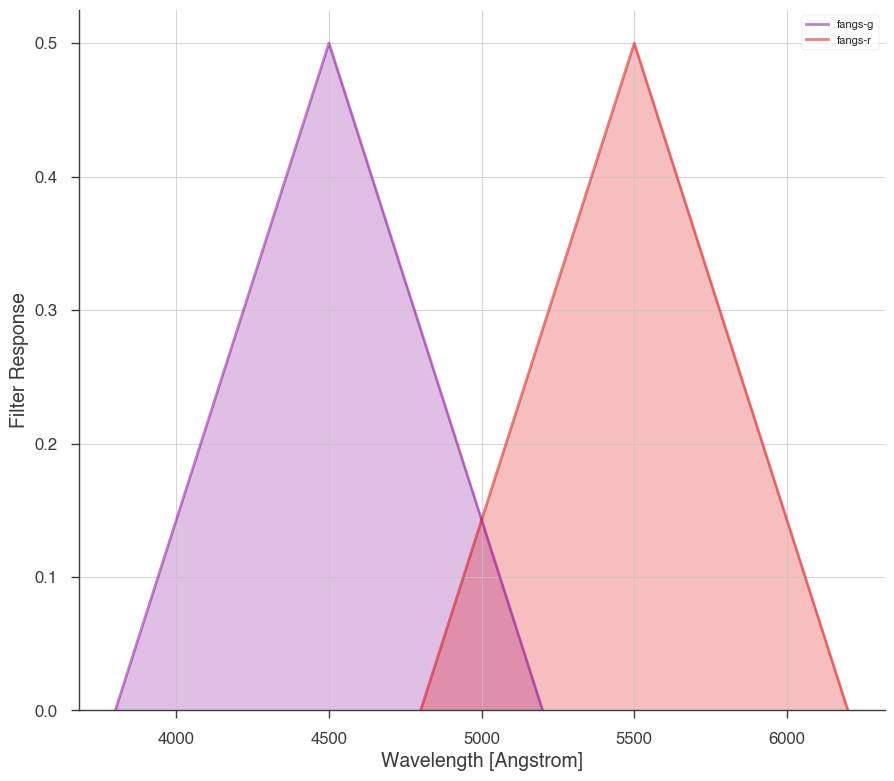
GROND Example
Now we will look at GROND. We get the filter from the 3ML filter library.
(Just play with tab completion to see what is available!)
[11]:
grond = PhotometryLike.from_kwargs(
"GROND",
filters=threeML_filter_library.LaSilla.GROND,
# g=(21.5.93,.23), # we exclude these filters
# r=(22.,0.12),
i=(21.8, 0.01),
z=(21.2, 0.01),
J=(19.6, 0.01),
H=(18.6, 0.01),
K=(18.0, 0.01),
)
[12]:
_ = grond.display_filters()
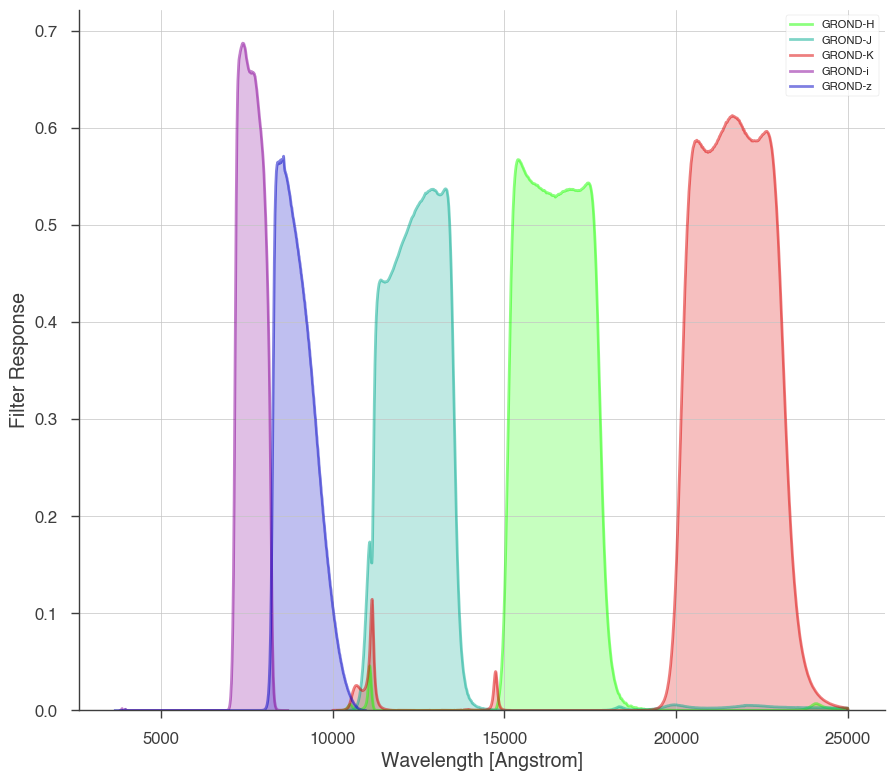
Model specification
Here we use XSPEC’s dust extinction models for the milky way and the host
[13]:
spec = Powerlaw() * XS_zdust() * XS_zdust()
data_list = DataList(grond)
model = Model(PointSource("grb", 0, 0, spectral_shape=spec))
spec.piv_1 = 1e-2
spec.index_1.fix = False
spec.redshift_2 = 0.347
spec.redshift_2.fix = True
spec.e_bmv_2 = 5.0 / 2.93
spec.e_bmv_2.fix = True
spec.rv_2 = 2.93
spec.rv_2.fix = True
spec.method_2 = 3
spec.method_2.fix = True
spec.e_bmv_3 = 0.002 / 3.08
spec.e_bmv_3.fix = True
spec.rv_3 = 3.08
spec.rv_3.fix = True
spec.redshift_3 = 0
spec.redshift_3.fix = True
spec.method_3 = 1
spec.method_3.fix = True
jl = JointLikelihood(model, data_list)
INFO set the minimizer to minuit joint_likelihood.py:1045
We compute \(m_{\rm AB}\) from astromodels photon fluxes. This is done by convolving the differential flux over the filter response:
\(F[R,f_\lambda] \equiv \int_0^\infty \frac{dg}{d\lambda}(\lambda)R(\lambda) \omega(\lambda) d\lambda\)
where we have converted the astromodels functions to wavelength properly.
[14]:
_ = jl.fit()
Best fit values:
| result | unit | |
|---|---|---|
| parameter | ||
| grb.spectrum.main.composite.K_1 | (4.60 +/- 0.12) x 10 | 1 / (cm2 keV s) |
| grb.spectrum.main.composite.index_1 | -1.144 +/- 0.011 |
Correlation matrix:
| 1.00 | 0.99 |
| 0.99 | 1.00 |
Values of -log(likelihood) at the minimum:
| -log(likelihood) | |
|---|---|
| GROND | 477.318107 |
| total | 477.318107 |
Values of statistical measures:
| statistical measures | |
|---|---|
| AIC | 964.636215 |
| BIC | 957.855091 |
We can now look at the fit in magnitude space or model space as with any plugin.
[15]:
_ = display_photometry_model_magnitudes(jl)
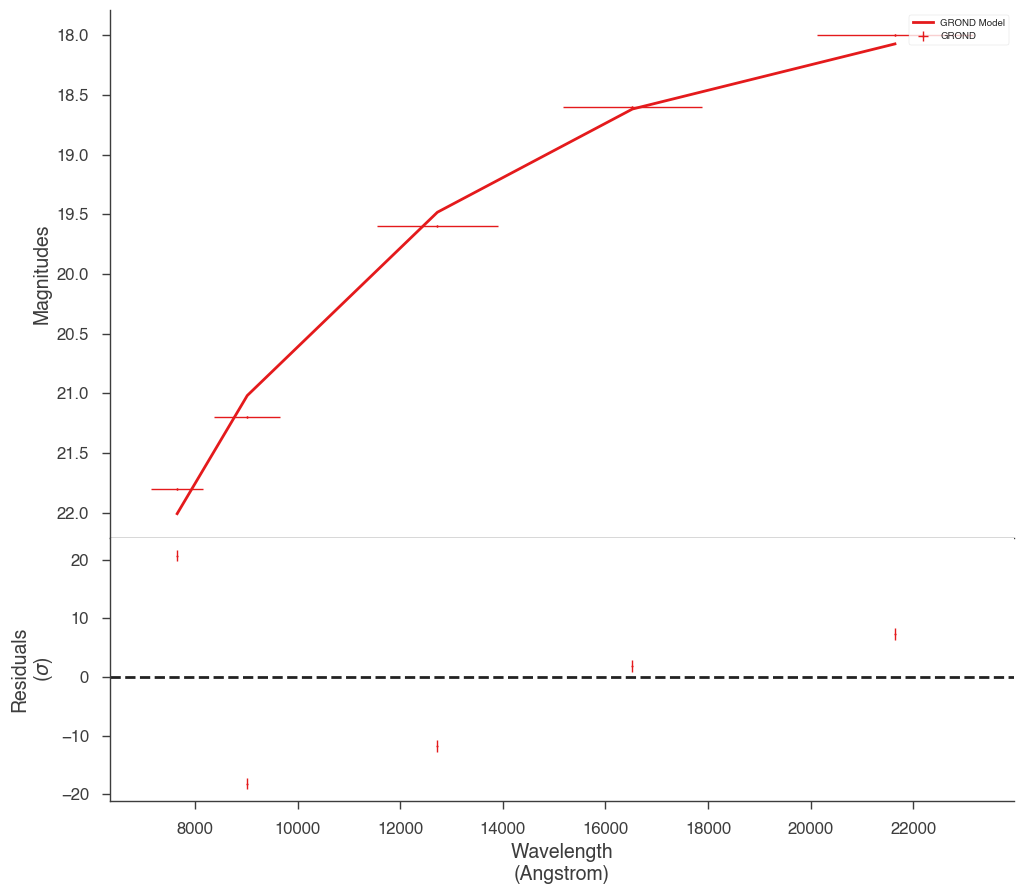
[16]:
_ = plot_spectra(
jl.results,
flux_unit="erg/(cm2 s keV)",
xscale="linear",
energy_unit="nm",
ene_min=1e3,
ene_max=1e5,
num_ene=200,
)
